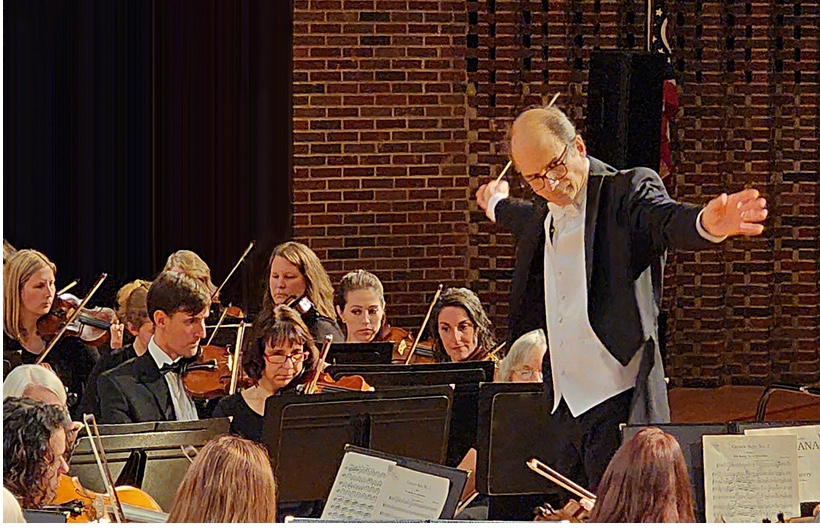by Jarrett Hoffman

It is the eternal struggle between two principles, right and wrong, throughout the world. It is the same spirit that says, ‘You toil and work and earn bread, and I’ll eat it.’ No matter in what shape it comes, whether from the mouth of a king who seeks to bestride the people of his own nation, and live by the fruit of their labor, or from one race of men as an apology for enslaving another race, it is the same tyrannical principle.
As I said to Parma Symphony conductor and music director Randolph Laycock during a recent interview, when a piece is as popular as this one, it can be easy to forget how powerful it is. “I’ve had more than one person say to me, ‘Wow, what a dramatic piece.’ It really gets to you,” Laycock said.
The Parma Symphony’s spring concert, which will take place on Sunday, May 7 at 3:00 pm at Valley Forge High School Auditorium, is built around Lincoln Portrait, and is full of music steeped in American history — all put together by a conductor who is also a Civil War buff.
Coincidentally, there is also a Civil War connection in the orchestra, and a personal one, as Laycock told me. A member of the second violin section approached him at the end of a rehearsal to share that she’s a descendent of Union Army general William Tecumseh Sherman. “She said, ‘I’m always so passionate about the Civil War, and this music brings tears to my eyes,’” Laycock recalled. “I said, ‘Oh my god.’ That’s really powerful.”
Of course, pairing Lincoln Portrait with Randy Edelman’s Gettysburg Symphonic Suite makes perfect sense historically. The Copland even ends with an excerpt from the Gettysburg Address, the famous speech Lincoln gave at the dedication of what is now Gettysburg National Cemetery, four-and-a-half months after that most deadly battle.
Speaking of speeches — Laycock said that one of the movements of the Edelman is actually titled “Gettysburg Address,” and that like the Copland, it includes narration. While Parma City Schools superintendent Charles Smialek will take up that role in Lincoln Portrait, the orchestra looked within — a couple of layers within, actually — for the narration in Gettysburg Symphonic Suite.
“I have a husband-and-wife combination in the orchestra — she’s a trumpet player and he’s my principal clarinet,” Laycock said. “They’ve been in the orchestra almost as long as I’ve directed it, which is 45 years. And they have granddaughters who are very intelligent — there are three of them, and they are going to narrate the entire Gettysburg Address in the middle of this movement. They’re young kids, but they came into rehearsal and did a nice job. I think it’s going to be a lot of fun.”
Filling out the program: John Williams’ theme from the 2000 movie The Patriot (set during the Revolutionary War), a medley of American popular tunes titled Americana — “and then of course you’ve got to end with Stars and Stripes Forever,” Laycock said. As for the Williams, that wouldn’t always be a no-brainer for the Parma Symphony. “We’ve been able now to get some extra funding, allowing us to do some John Williams music, which is normally too expensive for us to rent.”
Back to that big number — 45 years atop the podium, only a decade less than the entire history of the orchestra — I asked Laycock to say a little bit about what he remembers from the beginning of his tenure.
“Well, I’m a retired music teacher — I taught for 36 years in Parma as a band and orchestra director — and my original goal in my career was to teach in college. So when I first started with the group, I thought it would make a good stepping stone, because they’re much more advanced than the kids I was working with. I did end up teaching in college part-time — at Baldwin Wallace for 30-some years doing the youth orchestra program, and some at Tri-C. But the orchestra progressed over the years, and it got to the point that this is like a second family to me. They’ve done things that I’ve challenged them with, and they’ve done a really good job. And I decided, hey, I’m very content, I’m just going to stay here.”
Perhaps the Parma Symphony also feels like family in another sense: it mixes generations, bringing together talented adults as well as students. “I know there are a couple of octogenarians in the group, and then we have some people just out of high school, so it covers the waterfront really.”
What does that mixture bring to the ensemble? “In our case, the older folks are well-respected by the younger folks, who tend to learn from their elders. They all get along really well, and they’re just a great bunch of people. We have 80-some in the group — my father, who was a longtime music director, said, ‘You know, there’s always safety in numbers.’ And I’d say roughly two-thirds of that number have been there for at least 30 years,” Laycock said.
“They just love the music — they love coming to play. They’re in a position where they can have a good time and still make good music.”
Tickets are available here.
Published on ClevelandClassical.com May 3, 2023.
Click here for a printable copy of this article



